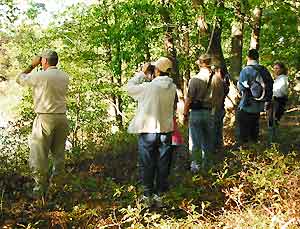Forests, Trees and Canopy Coverage
People in suburbia see trees differently than foresters do. They cherish every one. It is useless to speak of the probability that a certain tree will die when the tree is in someone's backyard . . .You are talking about a personal asset, a friend, a monument, not about board feet of lumber. —Roger Swain
Trees are an important part of our suburban infrastructure. Today there's a growing awareness that blending natural and built environments results in more attractive, efficient and sustainable communities. Keep reading to learn more about why trees are important to homeowners.
|
Trees increase property values.
Studies verify that homebuyers understand this and value the presence of established trees. Numerous studies show that trees typically increase property values by as much as 15%. A recent USDA study calculated that trees added 18% to the average sale price of a home in an upstate New York suburb. Many studies verify that trees save homeowners considerable dollars. In fact, properly placed trees can reduce cooling costs by as much as 30%. Some developers claim that clear cutting reduces construction costs, but discount cost reductions that can be realized by preserving existing mature trees, which eliminates replanting and the maximizes the value trees add to the price of the home.
Trees reduce electric bills.
Locally, regionally and globally, the cumulative benefits of conservation (using less energy) reach beyond the pocketbooks of individual home builders and buyers. Trees reduce the need for electric or gas energy, which conserves fossil fuels and reduces carbon emissions. This helps reduce air pollution, which is more than a just drain on our assets – it's a major human health risk.
Trees improve air quality.
Besides reducing energy consumption, trees improve air quality by absorbing carbon dioxide and other pollutants. For example, a single acre of trees absorbs enough carbon dioxide over one year to offset the amount produced by driving a car 26,000 miles. In Atlanta, Georgia, American Forests calculates that trees remove 19 million pounds of pollutants each year, which translates into an annual savings of $47 million. In Prince William County, if every person planted just one tree, we could reduce the amount of carbon dioxide in the atmosphere by over 4 million pounds every year.
Trees help keep drinking water clean.
Trees also are important to clean water in our reservoirs and rivers. Prince William's suburbanized landscape includes noteworthy amounts of impervious surfaces. Excessive amounts of water run off these hardened surfaces and, on the way to the closest waterway, pick up fertilizers, pesticides, oil, silt and other pollutants from the land.
This nonpoint source pollution – from our backyards, school grounds, malls and more – is the primary source of pollution. Water quality is clearly a problem in Prince William. A quick review of Virginia's new Dirty Water List, which includes the Occoquan Reservoir and many other local waterways, shows a serious pattern of degradation. Virginia's current budget issues, and history of underfunding water quality needs, highlight the need for preventive solutions.
Trees reduce stormwater impacts.
Today, although stormwater runoff issues are included as part of the rezoning process, it's still difficult to mitigate all impacts. Moreover, there's problems from the past, which already overwhelm available funding. In many older areas, no stormwater management was required for developments. Here, runoff flows to local creeks virtually unchecked. In some newer areas, the rate and volume of runoff now exceeds the capacity of existing stormwater systems.
 Trees increase the amount of water that filters into the soil, reduce runoff and increase groundwater infiltration. This protects waterways and helps recharge aquifers with clean water, helping to ensure a more consistent flow and quantity of drinkable water. Trees increase the amount of water that filters into the soil, reduce runoff and increase groundwater infiltration. This protects waterways and helps recharge aquifers with clean water, helping to ensure a more consistent flow and quantity of drinkable water.
Trees create a sense of place.
High quality trees and forests in suburban areas create a sense of place and community pride. Over the long run, trees convey an atmosphere of health and well being, help attract high quality commercial development and enhance the County's economic stability. In addition to their scenic and recreational values, trees provide environmental services that directly benefit residents.
Trees increase property values, help reduce utility bills, protect water quality, help recharge groundwater and prevent erosion. Trees clean our air, reduce sound pollution and make a significant contribution to the scenic quality of Prince William. Trees are major capital assets that provide local benefits and need local protection.
|